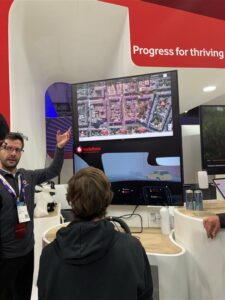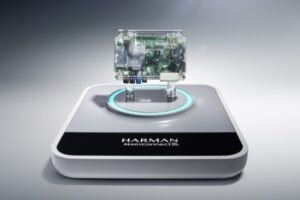AAVI recently visited the Mobile World Congress (MWC) 2024, which took place February 26-29 in Barcelona, Spain. The event has become increasingly important for the automotive industry, with a particular focus on mobility communication.
The Mobile World Congress serves as a pivotal platform for unveiling innovations and trends shaping the future of mobility. Among the myriad of advancements showcased at the event, particular trends were apparent in 5G technology, connected mobility solutions, automotive testing and the integration of autonomous vehicles into transportation ecosystems.
Companies participating in these areas – many of whom are members of the 5G Automotive Association (5GAA), a global coalition of automotive, technology and telecommunications companies – were at the show to demonstrate their commitment to driving forward the evolution of smart, safe and sustainable mobility solutions. Here are the key takeaways:
5G applications for AVs
Autotalks, a member of the 5GAA, presented its V2X technology for autonomous vehicles. The company’s Tekton3 chipset supports 5G-V2X communication. In partnership with Rohde & Schwarz, Autotalks showcased the capabilities of 5G-V2X radio links and demonstrated the encoding and decoding of data, which is essential for seamless communication between vehicles and infrastructure.

Rohde & Schwarz verified the performance of Autotalks’ third-generation V2X chipset. The Tekton3 and Secton3 chipsets were tested using the most recent 5G-V2X capability of the R&S CMP180 radio communication tester. Both chipsets support all four V2X side-link communication standards, including LTE-V2X, IEEE 802.11p (DSRC) and the new 5G V2X and 802.11bd.
Amos Freund, VP of R&D at Autotalks, commented, “Validation is a critical step in the product development cycle and a condition of an interoperable ecosystem. We are proud to work with R&S to test our third-generation device, the world’s first 5G-V2X chipset.”
Advances in testing solutions
Companies like Keysight Technologies and Rohde & Schwarz showcased their wireless communications solutions tailored to the needs of the automotive industry.
Keysight’s testing solutions enable innovators to address design and test challenges, particularly in the realm of 5G and connected mobility. Through demonstrations at the show of 5G advanced non-terrestrial networks (NTN) and sky-to-lab emulation, Keysight illustrated the capabilities of its solutions in validating 5G devices and satellite networks.
Similarly, Rohde & Schwarz presented its suite of automotive testing solutions, including 5G, eCall and C-V2X test equipment. With a focus on ensuring the performance and reliability of automotive communications, Rohde & Schwarz highlighted the importance of testing solutions in accelerating the adoption of V2X capabilities.
Two new setups for 5G RF and RRM conformance testing were introduced at MWC. The R&S TS8980S-4A is a single-box solution tailored to 3GPP inband test cases, and the R&S TS8980FTA-3A is a single-rack solution covering all inband and out-of-band test cases.
The R&S TS8980 is an official 5G conformance test platform approved by the Global Certification Forum (GCF) and the PCS Type Certification Review Board (PTCRB). Chipset, modem and end device manufacturers, as well as test houses, can use the test system to perform RF (TP298) and RRM (TP296) tests in line with 3GPP specifications.
Colm Mulligan, market segment manager of automotive at Rohde & Schwartz, commented, “5G is a new standard for V2X. Previously, there was LTE-based V2X but 5G brings a new functionality through two-way communication for more complex use cases.
“In simple terms, if I send you a message, you can tell me you received it. 5G has the potential to help future applications for things such as latency, where its dual communication capability should cut out the time delay. This is not as efficient in existing technologies because they are broadcast only and lack feedback capabilities. We can therefore solve problems together with the chipset maker.”
Enhancing road safety
Vodafone shared information about its Safer Transport for Europe Platform (STEP), aimed at improving road safety, security and accessibility for all road users. Through collaboration with transportation authorities, app developers and the automotive industry, STEP facilitates the delivery of crucial safety information to drivers in real time.
By harnessing the power of connectivity, STEP promotes safer road environments and enhances awareness among road users. At MWC, Vodphone showcased what future applications of the platform could look like.

Marcos Dias Silva, 5G and edge computing global expert at Vodaphone, elaborated further: “Having already been in the market for one and a half to two years, STEP is a platform that enables free communication for all intelligent transport systems. We have built a visual representation of STEP, keeping in mind what the future might look like for user experience in terms of road safety.
“The virtual representation simulates the road user experience, incorporating traffic signals, cyclists, pedestrians, emergency services and more. Here at MWC, our simulation mimics the city of Barcelona.”
Leveraging technologies such as 5G and mobile edge computing will help solve issues in the time delay between sending the message and the system that is distributing it. According to Silva, 5G can lower this delay by 20% to 30% more than its previous 4G generation.
When the move is made to 5G SA, a standalone operation of the 5G network, the time delay is expected to be lowered even more and this is anticipated to facilitate easier segregatation between quality channels.
In this mode, the 5G network is not reliant on any other network infrastructure and can operate independently.
“Grid edge computing is also expected to come into play, to aid the distribution value of communication and messages, making them highly regional. It essentially acts as a processing node within our network, allowing us to comply with IPS requirements and also lower latencies through the ability to read messages across users,” added Silva.
Road safety and automotive connectivity
Meanwhile, connected vehicle solutions provider Harman showcased its latest solutions designed to democratize automotive connectivity, including the Ready Vision QVUE system, which integrates audio and visual components to enhance driver safety by providing real-time updates and hazard alerts. The system leverages AR HUD hardware, navigation and ADAS sensor inputs, and an artificial intelligence/machine learning (AI/ML) software framework. It also utilizes non-intrusive displays with real-time contextual points of interest, accurate and timely updates and immersive audio designed to achieve a faster response time than visual alerts alone.
Powered by Samsung Neo QLED, it provides clear visual performance to minimize distractions by displaying relevant information closer to the driver’s line of sight.
Suman Sehra, global VP of product portfolio management and innovation at Harman, said, “New additions to the Ready product portfolio underscore the power of collaboration across diverse areas of expertise to boost safety, personalization and sustainability for auto makers and consumers.”
At the show, Harman also announced the launch of the Ready Connect 5G telematics control unit (TCU), which leveraged Qualcomm’s Snapdragon Digital Chassis technology.

Pascal Peguret, SVP of connectivity for Harman Automotive, added, “Harman Ready Connect 5G TCU is designed to meet the needs of auto makers simply and effectively, while expediting time-to-market and significantly reducing development cost.”
Through the Snapdragon Modem-RF Gen 2 system, the TCU offers connectivity performance while maximizing upgradability, scalability and usability. Qualcomm’s Snapdragon X80 5G Modem-RF System was demoed at MWC to showcase how safety for vehicles can be enhanced by combining cloud and cellular services to provide connectivity.
Using Snapdragon’s Cato cloud services and Auto Connectivity platform with low-latency 5G capability, it was demonstrated how connected services can improve awareness of pedestrians and other VRUs. The Snapdragon X80 5G Modem-RF System is a 5G modem-to-antenna platform that integrates 5G advanced capabilities and NB-NTN satellite communications support, for connectivity to non-terrestrial networks.

The platform is currently sampling, with commercial devices expected to launch in the second half of 2024.
The Snapdragon X80 features AI innovations based on a dedicated tensor accelerator that improves data speed, latency, quality of service, coverage, location accuracy, spectrum efficiency, power efficiency and multi-antenna management.
“The Snapdragon X80 Modem-RF System sets the stage for 5G advanced and the era of intelligent computing everywhere,” explained Durga Malladi, senior vice president and general manager, technology planning and edge solutions, Qualcomm Technologies.
“The system empowers OEMs and operators to create next-generation devices supporting 5G advanced, with unrivaled capabilities and leading performance.”


